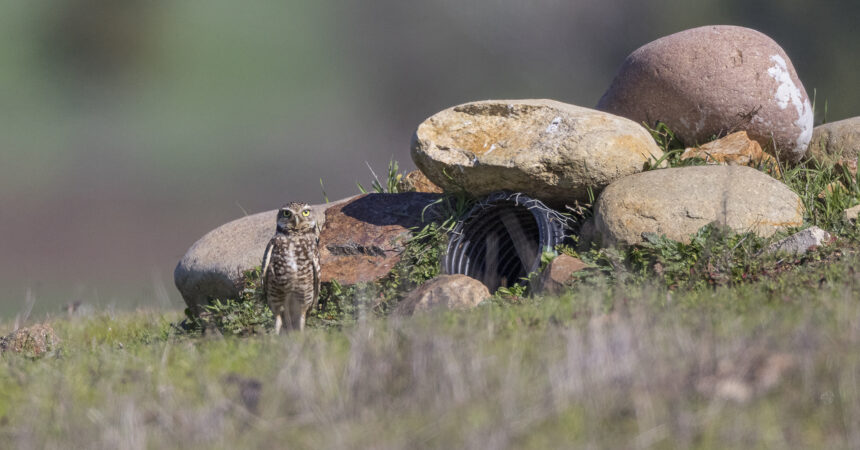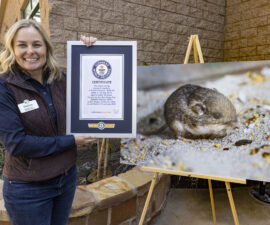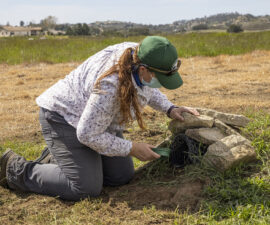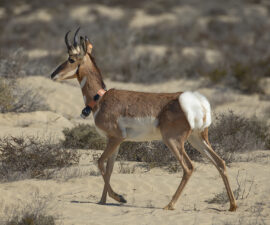SAN DIEGO (January 27, 2022)–— Western burrowing owls, a declining species in Southern California, are increasingly being forced from their homes by development. A research team led by San Diego Zoo Wildlife Alliance, in collaboration with the U.S. Fish and Wildlife Service Palm Springs office, developed novel techniques using a bit of creative advertising to protect the displaced owls, including painting rocks to look like stains from bird droppings and playing recorded vocalizations. Their methods, published in the journal Animal Conservation, are proving remarkably successful.
“When development projects impact a protected species, regulations require mitigation of those impacts, but unfortunately actions taken often are not enough to offset the harm done, and the species declines further,” said Dr. Ron Swaisgood, director of recovery ecology at San Diego Zoo Wildlife Alliance and senior author of the study. “Our goal was to solve the problems inherent with displacement and develop solutions that create a benefit for the owls.”
When burrowing owls are living in an area slated for development, they are typically evicted in one of two ways: They are forced to flee by collapsing their burrows ahead of construction, or they are physically moved elsewhere, a process called translocation.
“These owls play an important role in the ecosystem, helping control insect and rodent populations, and they depend upon burrows, made by small mammals, for their survival. When they are evicted from their homes, if there aren’t available burrows nearby for them to move into, their risk of mortality increases,” explained Colleen Wisinski, conservation program manager at the San Diego Zoo Wildlife Alliance, and an author on the study.
Translocating animals is becoming an increasingly important conservation tool due to escalating human impacts that make some areas unsuitable for wildlife. Conservationists are working to restore and protect areas where wildlife can thrive, but the species can’t always find these safe havens without assistance.
Translocating burrowing owls to a suitable habitat is more time and resource intensive, and unfortunately often results in the owls refusing to settle there. When they disperse, they may not survive. The research team undertook a three-year study to develop creative ways to tempt the owls to stay in the protected habitat for their own good to improve conservation outcomes.
“We know this species likes to live close to other owls. If they are released in areas without them, they might leave in search of another area with resident owls. But that search may be unfruitful as the species continues to decline,” said Swaisgood. “We wanted to find a way to trick the owls into believing other owls were living in the area to increase the chances they would settle there.”
To test the theory, for two weeks while the owls were acclimating in a pre-release enclosure, the researchers played recorded vocalizations of western burrowing owls to fool them into thinking there were resident owls living nearby. They also splattered white paint, resembling owl droppings, near the entry of burrows to persuade the newcomers that owls had lived there, and therefore, this must be a safe neighborhood for them.
“We fitted many of the owls with tiny GPS transmitters so we could track them and figure out where they went,” said Wisinski. “While some left immediately, others stayed and made the new site their home. Soon, many were breeding, and we were thrilled to see their chicks hatched and growing up in this safe protected place.”
“The results were remarkable! The owls were 20 times more likely to stay and make a home in the new location when these acoustic and visual cues were used,” said Swaisgood. “With this discovery, we now have new methods that can be used to minimize the impacts of development and successfully establish owls in safe, protected areas. Our goal was not to stop development, some of which was necessary to develop renewable energy to tackle climate change, but find a win-win solution for owls, people and the environment.”
San Diego Zoo Wildlife Alliance has been working to study, protect and recover western burrowing owls for more than 10 years.
###
About San Diego Zoo Wildlife Alliance
San Diego Zoo Wildlife Alliance is a nonprofit international conservation leader, committed to inspiring a passion for nature and creating a world where all life thrives. The Alliance empowers people from around the globe to support their mission to conserve wildlife through innovation and partnerships. San Diego Zoo Wildlife Alliance supports cutting-edge conservation and brings the stories of their work back to the San Diego Zoo and San Diego Zoo Safari Park—giving millions of guests, in person and virtually, the opportunity to experience conservation in action. The work of San Diego Zoo Wildlife Alliance extends from San Diego to strategic and regional conservation “hubs” across the globe, where their strengths—via their “Conservation Toolbox,” including the renowned Wildlife Biodiversity Bank—are able to effectively align with hundreds of regional partners to improve outcomes for wildlife in more coordinated efforts. By leveraging these tools in wildlife care and conservation science, and through collaboration with hundreds of partners, San Diego Zoo Wildlife Alliance has reintroduced more than 44 endangered species to native habitats. Each year, San Diego Zoo Wildlife Alliance’s work reaches over 1 billion people in 150 countries via news media, social media, their websites, educational resources and the San Diego Zoo Kids channel, which is in children’s hospitals in 13 countries. Success is made possible by the support of members, donors and guests to the San Diego Zoo and San Diego Zoo Safari Park, who are Wildlife Allies committed to ensuring all life thrives.





